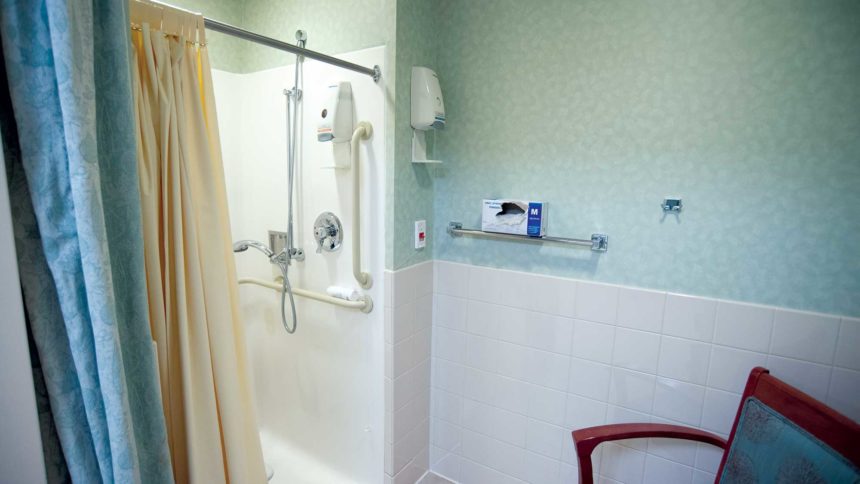
The past few years have changed attitudes and expectations about cleanliness with caregivers, family members, staff and policymakers. Not that long ago, for staff, bathing was more of a chore. And for residents, it was far less than a spa-like treat. Experts offer advice on how to ensure both are getting the best value when it comes to upgrading or improving the bathing experience.
1. While other factors might be enticing, putting residents first is a safe bet when it comes to maximizing a bathing area investment.
“SNFs have to step up their game like never before to keep market share,” said Patricia Howell, RN, clinical support manager for McKesson Medical-Surgical Extended Care. “They need to be innovative and embrace new technologies and ideas.”
Consider en suite bathrooms, which are getting more attention along with single-occupancy rooms. Howell calls the idea a “game changer” for enhancing residents’ dignity, privacy, choice and individuality. Two major benefits: reducing cross-contamination issues and saving staff time.
Comfort and privacy also are key.
“Neither staff nor residents want or will tolerate an immutable bathing time, which involves a humiliating transfer from a bed to a cold, unappealing bathing room,” said Karen Lerner, RN, clinical vice president at Drive DeVilbiss Healthcare.
2. Consumer preferences shift subtly, so it’s important to keep up with them.
Today’s residents expect bathing to be a high priority, said Todd Binsfeld, chief growth officer for Apollo Corporation.
“Unfortunately, this is where there’s a disconnect between residents’ expectations and facility abilities,” he noted. “Facilities are short-staffed and have not been able to accommodate true bath times and bathing cycles for every individual resident.”
But person-centered care requires an understanding of each resident’s preferences.
“It is faster, often easier, and much more efficient to shower residents versus offer baths,” said Kari Harbaugh, senior product consultant for Direct Supply. “Some residents even prefer showers to baths. It’s important to give them a choice.”
3. Managing expectations is an ongoing and critical exercise.
“Facility management should consider changing needs or expectations for incoming residents or they risk alienating referrals and potential residents, especially younger, healthier healthcare consumers that are with hip or knee replacements,” said Lerner.
It’s vital to meet your audiences’ desires, where possible. “Luxurious spa rooms are an attractive piece of the puzzle in increasing census,” added Binsfeld. “In SNFs, marketing to the overall living experience, including hygiene care, is marginal at best. Facilities offer so many great experiences, but that message has been diluted down.”
4. Owner-operators should never overlook the “little things” when trying to extract the greatest value from investments in bathing areas.
“Many facilities are moving to showers-only, which provide some level of hygiene at a low, but short-term return on investment,” said Binsfeld. “Meanwhile, true bathing, a 15-minute bath, takes the same time and energy as a shower, but provides several experiences that a simple shower does not.”
For facilities without capital for a complete remodel, consider a single bath or shower on each wing or floor, allowing for private bathing time with all the amenities of a nice spa area, advised Harbaugh.
5. To stretch your dollars and achieve maximum value from the investment, experts recommend generous investments in upgraded lifts.
“Using lifts to transfer from chair to tub significantly reduces the chance of a slip and fall injury,” said Pat Vanderheiden, vice president of Vancare. “Slips and falls in bathing areas can be prevented with several lift options. These vary from total lifts for the person who cannot transfer themselves to stand pivot lifts that help stand and pivot the resident from chair or commode to bath and back.”
6. Improving resident bathing satisfaction can go far in maximizing the resident experience.
“Overall resident satisfaction with bathing will correspond to improved quality care and better clinical outcomes which will help SNFs continue to attract referrals with positive Star Ratings and survey results,” said Lerner. “Ultimately, improved, dignified, private, clean, personal, and inviting bathing will help set apart one SNF from another.”
Mistakes to Avoid
- Not keeping tabs on changing expectations of residents. They’re demanding more.
- Ignoring where the biggest ROI is. It’s not what you think.
- Allowing resident satisfaction to slip. It’s dangerous.




